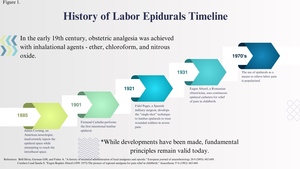Introduction
Most clinicians and patients have heard of “labor epidurals” but may have questions regarding their effectiveness, safety, and impact on maternal and fetal outcomes. While no substitute for consultation with an anesthesiologist, this Top Ten provides non-anesthesia healthcare providers with information they may use to provide guidance to patients as they make informed decisions regarding the best means to manage labor pain.
1. A labor epidural works by allowing titration of various pain medications via a catheter
A labor epidural involves the administration of local anesthetics, opioids, and other adjuvants into the epidural space via a lumbar epidural catheter, for the management of labor pain. The anesthesiologist will aim to provide sensory analgesia from the T10 level to the sacrum as indicated by the stage of labor. The intensity, dermatomal sensory level, and duration of the block can be enhanced through strategic, incremental dosing of epidurally-administered medications. The block may be maintained throughout the stages of labor via programmed continuous or intermittent infusion and may also incorporate a patient-controlled modality. Ultra-light solutions of bupivacaine and ropivacaine are the most used local anesthetics for labor analgesia, and both have favorable safety profiles when appropriately dosed for epidural administration. Compared to other forms of labor analgesia, a functional labor epidural can be titrated to the desired level of surgical anesthesia for cesarean delivery.1
2. A labor epidural is effective in providing labor analgesia and is used by many women
Endorsed by the World Health Organization (WHO), a labor epidural is considered the “gold standard” in provision of labor analgesia. Its use has increased dramatically in the last two decades. A 2013 multinational study examining intrapartum pain relief methods in 13 high-income countries found that approximately 4 in 5 nulliparous women and 2 in 3 multiparous women received labor epidurals in the United States.2
3. A labor epidural is an example of a neuraxial anesthetic
Neuraxial anesthesia refers to the administration of local anesthesia in or around the nerves of the spinal cord. A labor epidural is one example of a neuraxial anesthetic. Other neuraxial anesthesia techniques include single-shot and continuous spinal, combined spinal-epidural, and dural puncture epidural.
4. Labor epidurals date back to the early 19th century
While tremendous developments have been made, some fundamentals regarding labor epidural use remain relevant today. Figure 1 offers a historical timeline of the use of epidurals to provide labor analgesia.3,4
5. Racial and ethnic disparities exist in labor epidural utilization
A 2023 review found that black and Hispanic parturients had lower labor epidural utilization rate when compared to white women in the United States.5 Contributing factors for these disparities have been proposed in the literature and include racial inequalities in access to anesthesia, discouragement from family and friends, lack of intent and planning to receive epidural, insurance coverage or lack thereof, language barriers, clinical differences in pain perception, provider beliefs and behavior, and mistrust of healthcare system.6,7 Maximal efforts to eliminate healthcare disparities and achieve social equity are paramount and should include a strong focus on ensuring that all laboring mothers have access to adequate pain relief.
6. A labor epidural does not increase a woman’s chances of having a Cesarean delivery
In a landmark article published in the New England Journal of Medicine in 2005, it was demonstrated that neuraxial labor analgesia did not increase the rate of Cesarean delivery. In this study of 750 nulliparous parturients, neuraxial analgesia was administered early in labor (cervical dilatation <4.0 cm) and resulted in better analgesia and shorter duration of labor than systemic analgesia.8
7. A labor epidural offers advantages to women attempting a trial of labor after Cesarean (TOLAC)
For patients attempting TOLAC, a functional labor epidural may not only provide analgesia to mitigate pain from contractions, but it may also be extended to achieve surgical anesthesia should operative delivery be indicated. Its use in this patient population is supported by the American College of Obstetricians and Gynecologists and the American Society of Anesthesiologists.9 Escalating dosing requirements in a functional epidural may be a clinical sign of uterine rupture.10
8. A labor epidural is safe for both mother and baby
Anesthesiologists test the epidural catheter before using it to make sure it is in the right place. For the entire time that a labor epidural is in place, a mother’s blood pressure and oxygenation are closely monitored; fetal heart rate is continuously monitored. Epidural analgesia allows for less medication to enter the maternal bloodstream compared to intravenous and/or inhaled methods. A mother who has received a labor epidural may still breastfeed. There are currently no prospective studies suggesting a reduction in breastfeeding success linked to epidural use.
9. The risk for serious complications from a labor epidural is low
Serious risks such as hematoma (1:168,000), deep epidural infection (1:145,000), and severe persistent nerve damage (1:240,000) are very rare. The risk for developing post-dural puncture headache is 1: 100-500. The risk for inadequate or one-sided pain relief requiring epidural replacement is 1: 10-50.11
10. Some women may not be candidates for a labor epidural
To optimize maternal safety, the benefits to risks of a labor epidural must be weighed for each patient. Table 1 provides a listing of absolute and relative contraindications for labor epidural placement.
Conclusion
Clinicians may use the information presented here to fortify their understanding of labor epidurals. As a bonus, they are encouraged to further advance their knowledge by listening to the following Mississippi Public Radio Southern Remedy podcast that features one of the authors of this article: http://southernremedy.mpbonline.org/episodes/southern-remedy-for-women-epidurals-and-other-anesthetics.




